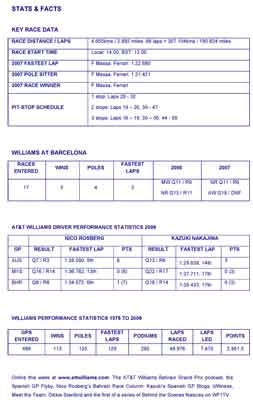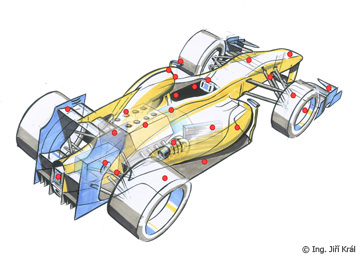Tisková informace - WilliamsF1 (EN)
Miroslav Sanytrák | 24.4.08 | Aktuality
22ND APRIL 2008
SPANISH GRAND PRIX PREVIEW
Formula One’s European season opens this weekend with the 37th Spanish Grand Prix
at the Circuit de Catalunya, located to the north of Barcelona in Montmeló. Hosting the
race for the 17th time, Catalunya is a favoured testing venue among the teams, and is a well known entity to the drivers who have all banked considerable mileage at the track
over the winter.
Following its return from Bahrain, the AT&T Williams team and its drivers, Nico Rosberg
and Kazuki Nakajima, have spent four days testing aero and mechanical updates at
Barcelona and is well prepared for making the short journey to Spain again this week for
round four of the FIA Formula One World Championship.
Once the Williams-Toyota FW30s complete 26 laps of the Spanish Grand Prix, the team
will celebrate the first of a series of landmarks this year having recorded 50,000 raced
laps in Formula One since Williams Grand Prix Engineering’s debut race in Argentina in
1978.
Nico Rosberg
I’m looking forward to this weekend’s Spanish Grand Prix because we know the circuit
well as we’ve done a lot of testing there in the past. The car performed well at Catalunya
throughout winter testing, so it should run well in the race. We had a promising test
there last week; I had two day’s preparation time with the car which should stand us in
good stead for the race. The only difficulty with Barcelona is that track conditions are
constantly changing so you’re frequently having to adjust your set-up. Malaysia is now
firmly behind us and I’m hoping we’ll come away from next weekend with a positive
result.
Kazuki Nakajima
We have some aero updates on the car for Barcelona, which we spent last week testing,
and they should bring us some gains performance-wise. Personally, I like the Circuit de
Catalunya. I had a good result there when I raced in GP2 last year and I hope I can do
well in my debut Spanish Grand Prix. My engineer, Xevi Pujolar, is from Spain, so it’s
technically going to be one of our home races, so I’m hoping I can get him a good result!
Sam Michael, Technical Director, Williams F1
Barcelona is a great test of aerodynamic efficiency, engine power and chassis balance. It
tends to highlight a car’s strengths and weaknesses, except perhaps the brakes because
braking loads in Barcelona are fairly minimal compared to other tracks because there are
numerous high speed corners with high lateral corner loads on entry and exit.
We have tested at Barcelona throughout the winter, and as recently as last week, during
which time we’ve fine tuned set-up and brought some aerodynamic and mechanical
developments to the car. Bridgestone will bring two tyres from the harder end of the
compound range for this race and strategy tends to lean towards two stops because the
high speed corners make a one stop option too difficult.
With the cars demonstrating good reliability now, our target for Barcelona is to continue
improving our performance and getting points in order to build upon our position in the
Constructors’ Championship, but it will be a tough battle.
Circuit de Catalunya, Barcelona
Regarded as one of the most technically challenging circuits on the calendar, it is
perhaps fortunate that the teams spend the majority of their allocated test days
collecting valuable data at Montmeló ahead of the race. Unfortunately, however, track
and weather conditions are invariably disparate between testing and the Grand Prix
weekend leaving the drivers and their engineers with a relatively green track to contend
with from the outset.
Barcelona is a high speed, high downforce circuit, with fast, sweeping corners
connected by even faster straights and will see the drivers reach speeds of 305kph
along the start/finish straight and fly into corners such as Seat at 240kph. The engines
will spend each lap of the 66 lap race at 57% full throttle, so top end speeds are
important, most crucially on the start/finish straight which will see the drivers flat out for
over a kilometre.
Barcelona’s erratic weather conditions, particularly the prevailing winds, can de-stabilise
the car’s aero balance, so the teams are continually chasing the perfect set-up. With so
many variables, the outcome of the Spanish Grand Prix should never be predicted.
|





